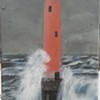Denmark has Hamlet. Sweden has Ikea. Iceland has green terrain (deceiving). And Norway and Finland are just kind of hanging out (possibly playing hockey). That's all I knew of Scandinavia, the cluster of countries that dangles over Europe like a senior's arthritic knuckles, until I attended ScanFest '05 last month.
Commencing the festival, representatives from each of the six countries stepped forward, flag in hand, for the playing of their national anthem. Sweden first. Then Norway, Finland, Iceland, Denmark and last but not least, the United States. Yes, I too was confused at first, but no one else questioned our inclusion into the Nordic union, so I just assumed we bought Greenland from Denmark when I wasn't paying attention.
Fittingly, among the dainty lady representatives in traditional, hand-stitched gowns, America's rep was a beefy soldier in a black cadet jacket and slacks. Not all the Scandinavian women had on dresses though. Denmark wore a lady's pantsuit because the man who was supposed to bring the traditional costume passed away earlier that week. Iceland sported a black fleece vest. Actually, Iceland wasn't really from Iceland; she was an imposter from Sweden. "There is one Icelandic woman in Charlotte, and she's out of town this weekend," announced Sanna Tucker, the festival's Finnish organizer.
As the lack of Icelanders might suggest, Scandinavian culture isn't exactly booming here: There are no cool Scandie enclaves or marketplaces to be found. Our few Charlotte Scandinavians are like the city's other transplants -- plucked from their native lands and plopped in our shiny city limits for a job. Tucker, a 13-year Charlotte vet says the Scandinavian population is only a couple hundred. When she first got here, a Finnish paper machinery company employed more than 100 Finish families, but when it closed most of the Finns left too.
Tucker started the Finland Club in 1997, which, along with Friends of Scandinavia, is designed to connect sparse and scattered Scandinavians in the area and create a place to celebrate the holidays (like June 3, the day the sun never sets in Scandinavia). In addition to teaching weekly Finnish classes, Tucker has organized ScanFest for both of its first two years.
Scandinavia can be translated to mean "danger island," from an old Germanic language. Sandbanks and reefs in the south of the peninsula have sunk many vessels over time. A more exciting explanation of Scandinavia's etymology involves the area's rich Norse mythology. Skandi, a giantess, sought revenge on the gods for killing her father but decided she could forget her murderous rage if she were allowed to select a husband from a line-up of gods. She was looking for a mate who could make her laugh but was won over by the beautiful feet of Njord instead. A bond built on a foot fetish is not made to last: The couple split because he wanted to live by the sea and she wanted to live in the mountains.
Like schoolmates in a classroom, Nordic countries' position relative to their neighbors has played a major role in shaping their personalities. Sharing a border with Europe has made the Danes the most outgoing, while Finland's proximity to Russia, its big, sullen bully to the south, has turned the Finns more soft-spoken. "Finns are the most cold," confirmed Riitta Virtaranta, a taciturn Finn. "We don't speak that much."
A language barrier has further served to isolate them. Finnish shares no relation with the North Germanic family of the others. Norwegians are more accustomed to regional dialects and can understand other Nordic languages the easiest. Swedes, in a country that has double the population of any other Scandinavian country, can get by anywhere speaking Swedish. This is the same theory that explains why there aren't more Haitian-speaking Americans.
The Danes love their flag the most (it's said to have fallen from the sky in 1219, making it Europe's oldest) and the Swedes get the least love -- for the same reason we are heavily criticized. "They export their culture the most aggressively," said Anne Brewer, a Norwegian-American. "They're not the only ones with meatballs," she added. Saunas are a Finnish invention, and even the Swedish masseuse (who was German) wasn't exactly sure why the international technique is attributed to the Swedes. She told me this as she rubbed and kneaded nonexclusively Swedish oil on my back.
The Norwegians have jokes to ridicule the Swedes. For instance: The Swedes invented the toilet seat, but the Norwegians figured out to put a hole in it.
And: Why do seagulls fly upside down from Norway to Finland? So they don't waste any shit on Sweden.
Inga-Lisa Peterson, a Swede who I didn't try my new jokes on, has missed her homeland's exports so much she's made the six-hour drive to the closest Ikea in Atlanta twice in the last year. It wasn't just a cheap furniture run she missed; the store sells Swedish cheeses and candies as well, some of which she shared with me.
Salt Lakrits is a popular licorice also known as a salt bomb. Of course, she didn't tell me this before I put a putrid piece in my mouth. I also sampled an ammonium chloride tablet that had a metallic aftertaste in addition to the sensation of swallowing a shaker's worth of salt.
Scandinavians love salt, mostly because preserving fish with it allowed them to survive for most of the last millennium. There is a 484-page book written on the compound called Salt: A World History. I only skimmed the chapter "A Nordic Dream," but if anyone wants to read it and send me a book report on other promising chapters, like "The Odium in Sodium" and "Big Salt, Little Salt," feel free.
Latest in Urban Explorer
More by Jared Neumark
-

Best of The Blotter 2007
Nov 28, 2007 -

Preaching and drinking
Mar 7, 2007 -

Preaching and Drinking
Dec 27, 2006 - More »
Calendar
-

NEW WINDOW GALLERY-Pat Rhea-ACRYLIC PAINTINGS-April 05-30 2024 VALDESE, NC 28690 @ New Window Gallery/Play It Again Records
- Through April 30, 12 p.m.
-

TheDiscountCodes
-

"Blood Residue Analysis of Paleoamerican Stone Tools in the Carolinas" @ Native American Studies Center
- Fri., April 26, 12-1 p.m.
-

Brightfire Music and Arts Festival @ GreenLife Family Farms
-

ARTS RENAISSANCE, a GALA supporting the ARTS in South Carolina @ the Columbia Museum of ART








